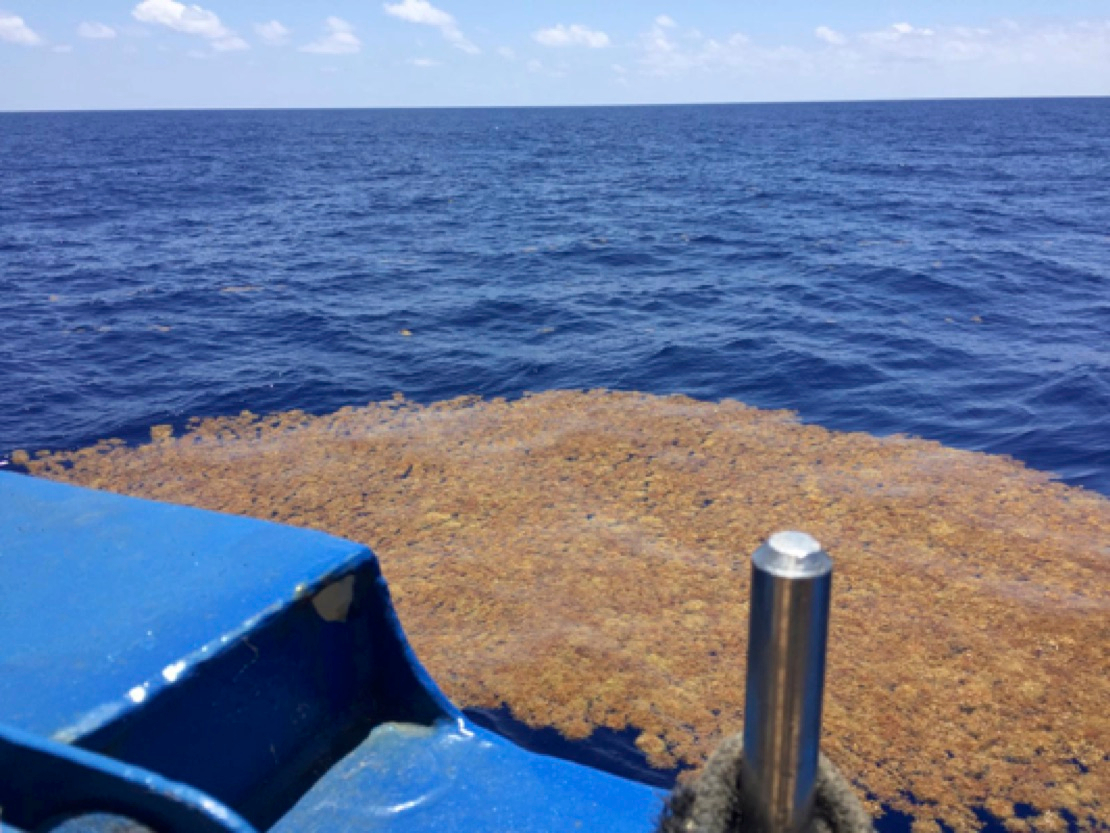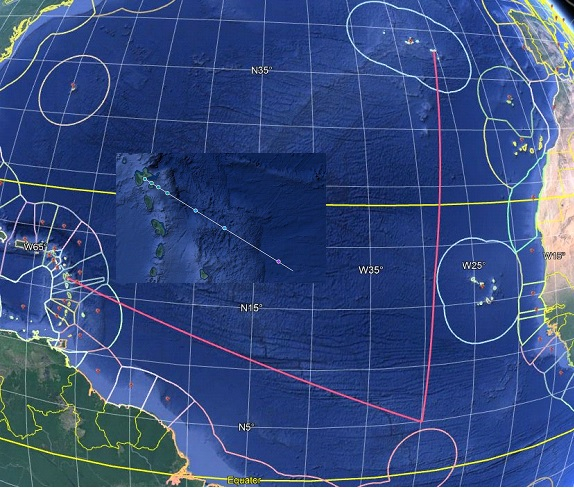Overarching questions that remain unanswered include: What genetic forms of pelagic Sargassum are involved, and what is the cause and geographic source of these accumulations? As “ecosystem engineers”, how do mass accumulations of Sargassum impact the microbial food web that dominates the open ocean, as well as coastal ecosystems where it strands?
One widespread hypothesis surrounding these unprecedented accumulations is that nutrients supplied by the Amazon and Congo River basins and also equatorial and coastal upwelling regions along Africa are allowing faster growing holopelagic Sargassum forms to reach very high concentrations. Other possible factors include climate-induced changes in water temperature, inputs of micronutrients from Saharan dust, and changes in currents causing seasonal consolidation and flushing from the North Equatorial Recirculation Region (NERR) bounded by the North Equatorial Counter Current and the South Equatorial Current.
The RV Pelagia "Sargassum" Cruise PE-455 aims to address these questions with a cruise departing the port of Ponta Delgada, São Miguel in the Azores, Portugal and heading south to the NERR in order to capture clumps of Sargassum for population genomics work but also to conduct a series of on-deck bioassay manipulation experiments (e.g. nutrient additions, dust additions) and in situ field samplings. Chief Scientist Linda Amaral-Zettler's primary objective will be to survey NERR for Sargassum population structure and test whether that region is source for the Caribbean inundations and also do experiments to determine what affects growth rates. A secondary objective involves collecting and comparing the Plastisphere microbial community to that on Sargassum and in the surrounding seawater. Co-PI Corina Brussaard's primary objective is to look at overall microbial productivity and virus activity in and below dense Sargassum mats vs. open ocean waters. Ideally we can find Sargassum patches in the NERR and move toward the Sargasso Sea to look at S. natans genotype 8 vs. other genotypes for both projects. We will plan to adjust cruise track and timing based on what we find as we approach NERR and also satellite data for Sargassum patches.
Major sampling equipment available includes a carousel with 24 each 10L Niskin bottles and a SeaBird CTD with additional sensors including light, oxygen, transmissometry, and chlorophyll fluorescence. There is also a 30 cm diameter box corer with video capabilities, and a 70 cm diameter, 500 µm-mesh manta trawl. There is an inflatable boat that will be used periodically for specialized sampling.
We hope you'll enjoy reading our blog!
August 12th | Islands of Opportunity
We arrived in the the port of Point-àu-Pitre, Guadeloupe around 1630 yesterday guided by a pilot vessel and windrows of Sargassum during our approach. Leaving the Dutch island of Texel in early July, setting sail from the Portuguese island of São Miguel, and now returning to the French island of Guadeloupe over a month later, we have remarkably never left Europe. These three islands are connected via the European Interreg project called "Islands of Innovation" that targets business innovation solutions that maintain sustainable practices while preserving local island talent and culture. Islands face unique challenges but also opportunities - if the right actions are taken to meet them. Sargassum presents a unique challenge to many Caribbean islands including those within France and the Kingdom of the Netherlands: like plastic pollution, massive accumulations of species of the open-ocean floating brown alga called Sargassum do not respect geographical boundries or EEZ's. As such Sargassum is not a problem restricted to a single country or continent - but a global problem requiring international cooperation and support. Our cruise has provided an opportunity for a collection of scientists from three continents to study this phenonomen in greater detail. Innovative solutions to this problem await - but must be guided by sound research.
Being board a research vessel is alot like being on an island - a strong community develops through cooperation and collaboration and innovative solutions solve challenges met along the way. As Chief Scientist aboard PE455, I am grateful to an amazing sailing and science crew during this cruise. It has been an extraordinary voyage - an encounter with what appears to be an expanding habitat in the middle of a nutrient deplete oceanic desert. I hope the spirit of collaboration and motivation to study this expanding habitat and the reasons behind it continue beyond the end of our voyage as we return to our final destinations. Safe Travels, Bon Voyage, Boa Viagem, Buen Viaje, Gute Reise, Goede Reis.
Linda Amaral-Zettler
NIOZ Chief Scientist, 64PE455
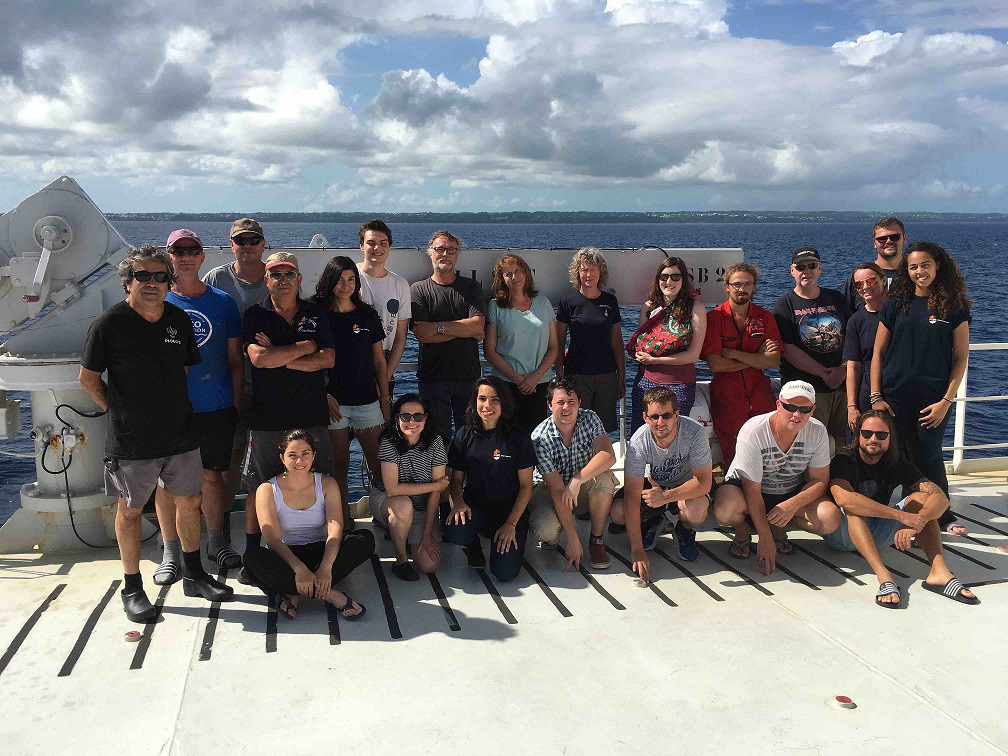
August 9th | Zen Moments at Sea
In my earlier blog, I mentioned that we go out with a rubber boat to sample in and out the Sargassum patches. Before we can go, we have to load the rubber boat with our 10 L sampling bottles, the pumps, the box with gloves and bags and all. Besides we also take freshwater with us because it can be rather hot out there on the big ocean! Leaving R/V Pelagia where one can see the Sargassum patch clearly, it is strange to realize the first time out there that the view from the rubber boat is highly limited and we need the Pelagia to communicate with us where to go. Once in the patch and the engine is off, there is this overwhelmingly nice feeling: no additional noise and the delayed wave action (due to the Sargassum on top of the water) makes you appreciate this unique way of sampling. Until one realizes that this is only true because there is the big ship nearby!
We use hand-pumps that suck vacuum and this way we gently suck up the water from different depths into the bottles which are shielded from the light to protect the algae. We work in a steady pace and since the pumps are quiet, we can stay in the “Zen moment”. Now I have to say that the sun or the rain we experienced while sampling does make it a wet Zen experience. Back on the Pelagia, the samplers quickly change cloths while the other 2 of the team quickly start working using these samples. The crew is luckily willing to accommodate not only these boat trips but also help to get the bottles into the temperature-controlled laboratory container as soon as possible.
Sailing on the ocean gives anyways a delayed feeling of time: there is the rhythm of the daily sampling, the searching for Sargassum, the meals and the daily cleaning of the sampling gear and labs. Hardly any time left for checking one’s emails and the news. Our cruise track furthermore took place in a part of the Atlantic Ocean not heavily sailed on and so we have not seen a ship in weeks. The few birds are astray and not many larger animals (a few times dolphins and once a few orcas in the distance). There are however, the many fish under and near the Sargassum patches and of course the flying fish. The latter are using their fins as wings when they ‘jump’ out of the water to escape predators or the Pelagia.
A few days more before we depart, and especially these last days I try to enjoy the ocean for all its beauty a bit more often in between rinsing sampling gear and bottles, packing it all up again, and cleaning equipment and lab containers. Yes, we have been really lucky with the calm seas so far!
Corina Brussaard, NIOZ 64PE455 Principal Investigator
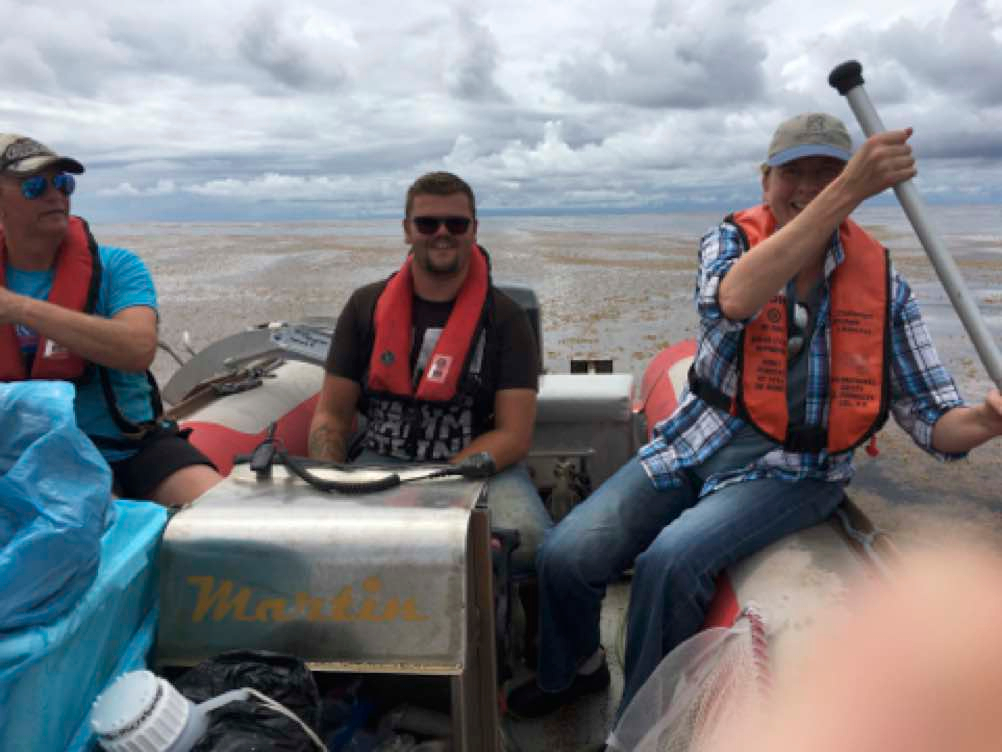
August 7th | Into the Great Sargassum Belt
The view of the R/V Pelagia from open waters in a 4-person Zodiac rubber boat in the middle of the Tropical Western Atlantic is already a humbling experience, but coupling it with being enveloped by a river of golden Sargassum macroalgae, is beyond words. Schools of Mahi Mahi fish pass below in irrescecent blue flashes and an occasional fish flops out onto the Sargassum canopy as if sunning itself on a watery beach.
We are entering week 4 of our nearly 5-week long voyage and the quantities of Sargassum macroalgae are too large to measure with a Manta Trawl at times, and so we have resorted to scooping them up manually with a dipnet into large bins to estimate the different proportions of species present. The large patches we encountered like this one are not commonplace but when they occur, it seems that they are a permanent part of the seascape. However, they can easily fall apart and come back together again as the winds and waves influence their persistance. Mass accumulations like these patches are such a stark contrast to the images of stranded Sargassum seen rotting on beaches of nearby Caribbean Islands.
Not surprisingly our work thus far has generated as many questions as answers to some of our research objectives. We have been blessed with overall calm seas and sunny weather - having only experienced one dramatic lighting and thunder storm. Surprisingly the Sargassum patch we were studying that day stayed intact despite the heavy rains and we were able to return to it the next morning.
Linda Amaral-Zettler, NIOZ Chief Scientist, 64PE455
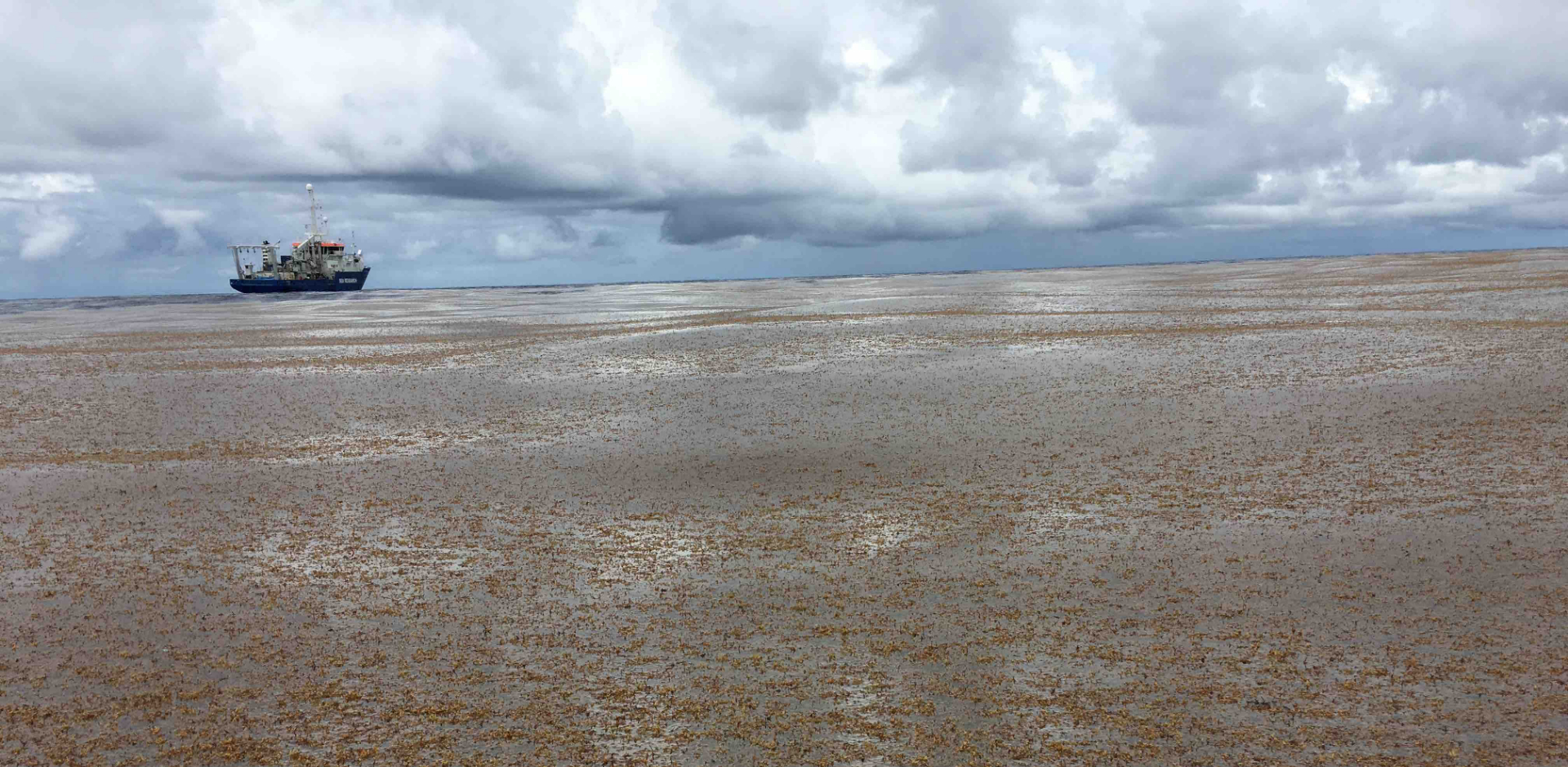
August 5th | Ecophysiology in floating Sargassum species
Three years ago, I switched from studying the Mediterranean to the Caribbean Sea, right around the time Sargassum began accumulating on the shores of Mexico in unprecedented quantities. Since then, I've been working as a postdoctoral researcher at the Institute of Marine Sciences and Limnology at UNAM, mainly studying the impact of massive strandings of Sargassum on seagrass communities.
Recent studies point to the north-equatorial recirculation region (NERR), and not the Sargasso Sea, as the origin of this phenomenon and that is where we are onboard the RV Pelagia.
What in the open sea constitutes a fascinating ecosystem of high ecological value, has become one of the greatest environmental and socio-economic challenges facing the Caribbean. A threat that puts the sustainability of the ecosystem at stake as we know it.
The holopelagic Sargassum species spend their entire lives floating on the surface of the sea, where they can form extensive patches that are subject to high levels of solar radiation. As part of this multidisciplinary project, one of our goals is to study the photo-acclimation mechanisms that allow these species to live in such an environment. We are also interested in knowing more about their photosynthetic performance under different environmental conditions, among them nutrient concentrations, given the increasingly high concentration of nutrients in some regions of the ocean.
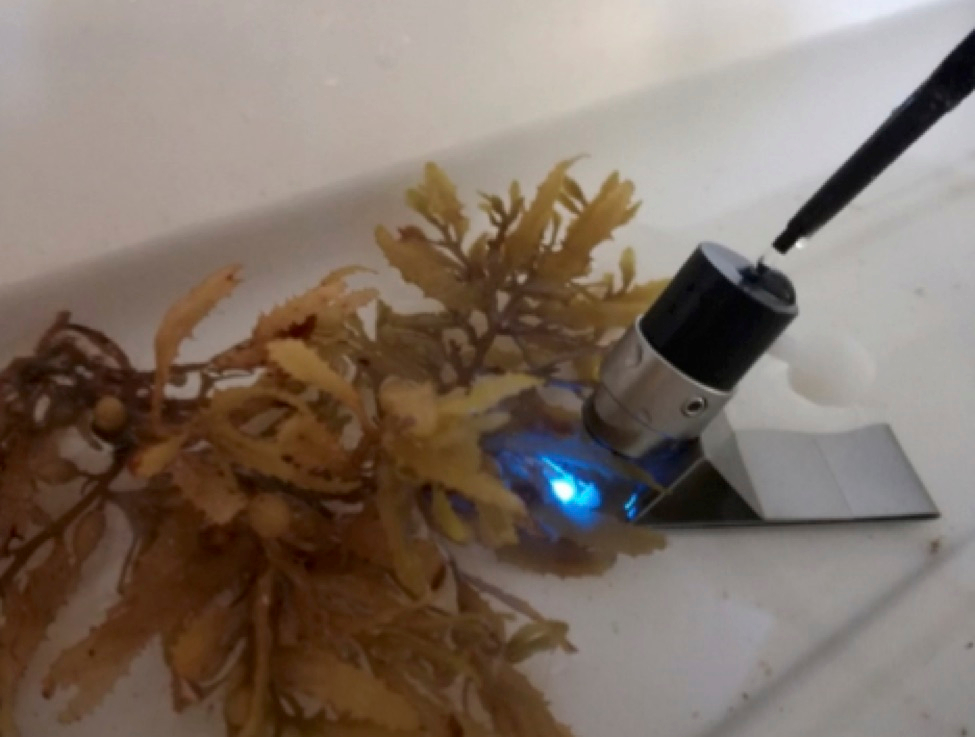
Español: Hace tres años cambié el Mediterráneo por el Caribe, justo cuando el sargazo comenzaba a llegar a las costas de este mar en cantidades sin precedentes. Desde entonces, trabajo en México como investigadora posdoctoral en el Instituto de Ciencias del Mar y Limnología de la UNAM, principalmente estudiando el impacto que tiene la llegada masiva de sargazo sobre las comunidades de pastos marinos.
Estudios recientes apuntan a la zona de recirculación nor-ecuatioral, y no al Mar de los Sargazos, como el origen de este fenómeno y justo en esa área es donde nos encontramos a bordo del RV Pelagia.
Así, lo que en mar abierto constituye un ecosistema fascinante y de alto valor ecológico, se ha convertido sin embargo en uno de los mayores retos ambientales y socioeconómicos que debe enfrentar el Caribe. Una amenaza que pone en juego la continuidad del ecosistema tal y como lo conocemos.
Estas especies de sargazo pasan toda su vida flotando en la superficie del mar, donde pueden forman extensas manchas, y por tanto se encuentran sometidas a elevados niveles de radiación solar. Como parte de este proyecto multidisiplinar, uno de nuestros objetivos es estudiar los mecanismos de fotoaclimatación que han permitido a estas especies adaptarse a vivir en un ambiente así. También nos interesa saber cuál es su rendimiento fotosintético bajo diferentes condiciones ambientales, entre ellas la concentración de nutrientes, dada la cada vez más elevada concentración de los mismos en algunas regiones del océano.
Marta García-Sánchez
PhD researcher at Instituto de Ciencias del Mar y Limnología (Universidad nacional Autónoma de México) with Dr. Brigit van Tussenbroek
August 4th | Estimating Sargassum Biomass with a GoPro Camera
The massive strandings of Sargassum to Caribbean coasts are an unprecedented phenomenon. The resulting stagnation of the algae causes an excessive accumulation of organic material on beaches. The rotting Sargassum produces a foul odor and changes the color of the water, from its characteristic turquoise blue to brown. These kinds of changes have an impact on the health of coast ecosystems. In addition, it also reduces the scenic beauty of the Caribbean beaches with big repercussions for tourism, the economic base of most areas of the Caribbean.
The Sargassum problem is a challenge and we still need a lot of information to help us understand its causes and come up with solutions. In Mexico, several research centers are researching the topic of Sargassum from different perspectives. Part of the research that we lead at the Engineering Institute of the National Autonomous University of Mexico, where I am currently doing my PhD, deals with topics such as: the ecological, economic and social impacts of Sargassum in coastal areas; the use of Sargassum as a raw material; the link between climate change and Sargassum arrival; and, the connection between oceanographic phenomena and Sargassum distributions.
During this expedition, we are very interested in estimating the abundance of Sargassum in different areas of the ocean. Estimating the densities of Sargassum in different areas of our journey, between the Azores and Guadeloupe, will provide us with invaluable information on the areas of great proliferation of Sargassum. In order to achieve this goal, we use a GoPro camera to take panoramic photographs, using methods suggested by Matthias Egger at Ocean Cleanup in the Netherlands for estimating plastic. With the help of known angles and distances, the photographs help us to calculate the approximate densities of Sargassum in different areas in our route. Through this study we hope to gather invaluable information to have a better understanding of why Sargassum arrivals occur on Caribbean beaches.
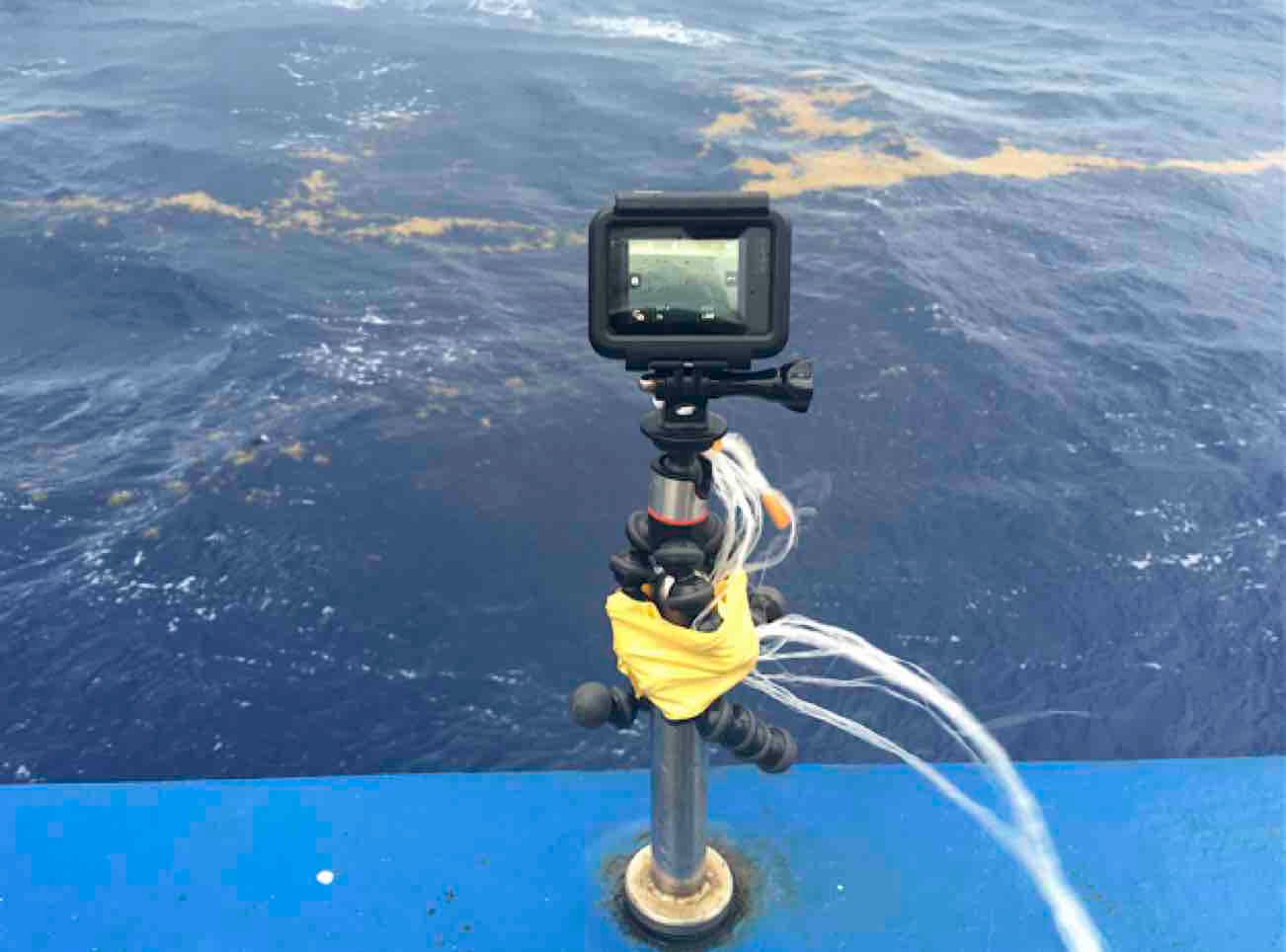
Español: Los grandes arribazones del Sargassum en las costas del Caribe son un fenómeno sin precedentes. El consecuente estancamiento de las algas causa una acumulación excesiva de materia orgánica en las playas. El Sargassum en descomposición produce un olor fétido y un cambio de color del agua, de su característico azul turquesa a marrón. Estos cambios tienen repercusiones en la salud de los ecosistemas costeros. Así mismo, disminuyen la belleza escénica de las playas del Caribe, lo que conlleva a repercusiones en el turismo, que es la base económica de la mayoría de las zonas del Caribe.
El problema del Sargassum es un reto y todavía nos hace falta mucha información que nos ayude a comprender sus causas, y a solucionar este problema sin precedentes. En México, varios centros de investigación están estudiando del Sargassum desde diferentes perspectivas. Parte de la investigación que se realiza en el Instituto de Ingeniería de la Universidad Nacional Autónoma de México, donde actualmente realizo el doctorado, aborda temas como: El impacto ecológico, económico y social del Sargassum en las zonas costeras; el aprovechamiento del Sargassum como materia prima; la relación entre cambio climático y los arribazones de Sargassum; la relación entre los fenómenos oceanográficos y la distribución del Sargassum.
En esta expedición, tenemos un gran interés por estimar la abundancia del Sargassum en diferentes áreas del océano. Estimar las densidades de Sargassum en diferentes áreas de nuestro viaje, que va de las Azores a Guadalupe, nos proporcionará información valiosa de los centros de gran proliferación del Sargassum. Para alcanzar este objetivo, en nuestro estudio utilizamos una cámara GoPro con la que realizamos fotografías panorámicas, utilizando el método sugerido por Matthias Egger en el proyecto "Ocean Cleanup" en Holanda para la estimación de los plásticos. Con ayuda de los ángulos y las distancias conocidas, las fotografías nos permiten calcular las densidades aproximadas del Sargassum en diferentes áreas dentro de nuestra ruta. Mediante este estudio esperamos recopilar información valiosa para tener un mejor entendimiento del porqué se presentan los arribazones de Sargassum en las playas del Caribe.
Izchel Hernandez
PhD candidate with Dr. Rodolfo Casarin at the National Autonomous University of Mexico
August 2nd | Just as impressive as a real Manta
Welcome to my blog about our work aboard the research vessel the Pelagia. I am a Masters student in marine biology that had the privilege to join this exciting cruise. Currently I am doing my last internship at NIOZ with Linda Amaral-Zettler, Erik Zettler and Fons de Vogel. That is right, the topic of my internship is on plastics and the selective culturing of biodegrading microbes to be precise. Most of the work aboard this cruise focuses on the open-ocean floating macro-alga Sargassum and its microbial community, but macro- and microplastics co-occur with bigger and medium-sized patches of the seaweed. Therefore, we are performing Manta trawls on a regular basis to quantify and preserve microplastics in the top layer of the water column and using in situ pumps to quantify micro- and smaller plastics in the entire water column. In this blog the focus will be on Manta-trawl quantification.
The Manta trawl is a net (in a frame that has the appearance of a Manta Ray) that is towed next to the boat, cruising at 2 nautical miles per hour, for 30 minutes in our surveys. Everything in the top 15 cm of the surface is collected in a jar at the base of the net (called the cod-end). With every trawl we sample for DNA analysis and microscopy of the biofilm attached to the plastic samples. The remaining plastics are quantified and saved for chemical analysis.
So far, we have been sampling regularly along our cruise track in the open ocean and in close proximity to Sargassum patches. On our way South from the Azores we observed a lot of microplastics. However, since we have reached the NERR, the quantity of microplastics has decreased with every trawl. From an environmental perspective this is a great observation, but as a scientist I was expecting (and maybe even hoping) the opposite to occur. Especially since the macroplastics are very obvious and abundant within the patches, which we are also sampling for DNA analysis and microscopy.
Nevertheless, we will keep on trawling until the end of the cruise and when we don't encounter microplastics in our net, we will still quantify the amount of Sargassum caught. Who knows, we might again observe more microplastics as we head North towards the island of Guadeloupe. Likely even different biofilm compositions, but that remains to be determined in the future. To be continued…
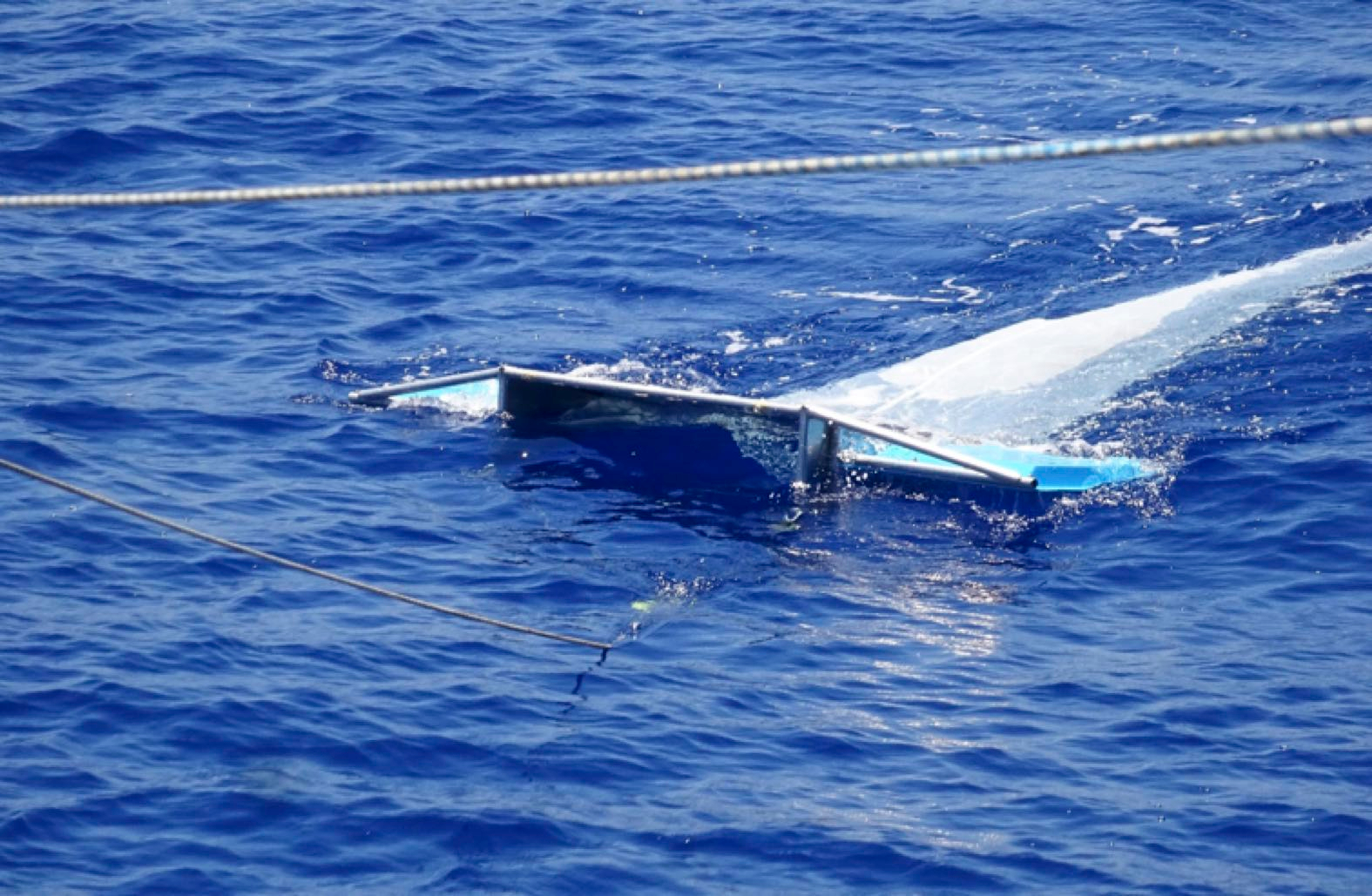
Nederlandse versie: Hierbij de volgende blog over het werk aan boord van het onderzoeksschip de Pelagia. Ik ben een master student in marine biologie, die het voorrecht heeft om deel te mogen nemen aan deze interessante cruise. Op het moment ben ik bezig met mijn laatste stage aan het NIOZ met Linda Amaral-Zettler, Erik Zettler en Fons de Vogel. Het klopt dat Sargassum niet het onderwerp is van mijn stage. De afgelopen maanden ben ik bezig geweest met isoleren en identificeren van biodegraderende microben, met name van biologisch afbreekbare en composteerbare plastics. Het meeste werk aan boord richt zich op de open oceaan drijvende macro-alg Sargassum, maar macro- en microplastics zijn ook te vinden in de medium patches van het bruinwier. Om dit te kunnen kwantificeren gebruiken we de zg. Manta-trawl en in situ pompen in respectievelijk het oppervlaktewater en de gehele diepte van de oceaan. In deze blog zal ik me voornamelijk focussen op de Manta-trawl kwantificatie.
De Manta-trawl is een net (gebonden in een stalen frame dat doet denken aan een echte manta rog) dat wordt voortgetrokken naast de boot, varend met 2 knopen, voor een half uur. Alles in de bovenste 15cm van het oppervlaktewater wordt opgevangen in een pot aan het einde van het net. Bij elke survey worden monsters genomen voor DNA- en microscopische analyse van de biofilm op de plastics. De overgebleven plastics worden gekwantificeerd en bewaard voor chemische analyse terug op Texel.
Tot dusver hebben we op regelmatige basis gesampled in de open oceaan en in de buurt van patches Sargassum. Op onze weg richting de evenaar waren we in staat veel microplastics te vinden in onze surveys. Daarentegen is het aantal microplastics afgenomen sinds we de NERR zijn binnen gevaren. Vanuit een groen oogpunt is dit goed nieuws, maar als wetenschapper had ik het tegenovergestelde verwacht. Zeker omdat de macroplastics duidelijk aanwezig zijn in de patches, welke ook gesampled worden voor DNA- en microscopische analyse.
We zullen op regelmatige basis door blijven gaan met sampelen tot het einde van de cruise en als we geen plastics in ons net vinden, zal het Sargassum nog steeds worden gekwantificeerd en geproportioneerd. Wie weet, vinden we wel meer plastics als we noordwaarts gaan richting het eiland Guadeloupe. Wellicht ook een andere samenstelling van de biofilms, maar dat dient beantwoord te worden in de toekomst. Wordt vervolgd…
Michiel Klaassen
MSc Student in the Amaral-Zettler Research Group at NIOZ and the University of Amsterdam
July 31th | Sampling the Microbial Ocean
My name is Claudia Meyer and I will start as a PhD student at NIOZ and the University of Amsterdam in October. My work will focus on how different viruses infecting the same phytoplankton hosts can coexist and on the ecological implications of this coexistence for the host. Since the majority of my work will be lab or computer based, I seized the opportunity when my supervisor, Prof dr Corina Brussaard, offered me a chance to join this cruise and explore the ocean.
A large part of my work here on board is spent filtering liters and liters of seawater, that we retrieve via Zodiac and CTD sampling, to collect DNA from algae, bacteria, as well as from virus particles. We started a North-South transect from the Azores down to almost the equator, and now we are taking samples as we head west, towards the Caribbean. We sample water from different depths ranging from just below the surface down to the DCM (deep chlorophyll maximum). With the Zodiac, we take samples from directly below patches of Sargassum, which is turning out to be quite challenging. Back at NIOZ we want to conduct molecular analysis of these filters, hoping to learn more about the occurrence and community compositions of the microbes and their viruses. Our sampling not only yields valuable scientific samples but also makes for a good work-out: many litres of water have to be carried to our container lab and the many sampling containers, bottles, and tubes have to be thoroughly rinsed after each sampling station.
Apart from samples for molecular analyses, our main focus is on analysing the compositions and interactions of the different groups that make up the microbial food web. For instance, we perform assays for bacterial production, grazing, and virally induced mortality. We have also set up a row of experiments to isolate new algal strains, as well as new potential viruses from the water samples that we take. For the latter we brought a collection of algal strains from the culture collection at NIOZ with us, which we inoculate with the sampled seawater. Working with living specimens (the cultures and the seawater samples we take) is always a challenge, but even more so on board a research vessel. Sampling has to be done as gently as possible to prevent damage to the cells. As the microbes we collect from different depths are very sensitive to changes in temperature, light intensity and water chemistry, we have to make sure that all their demands are met as closely as possible. For my cultures it means that if I succeed in keeping them alive during the cruise (so far so good!), these new strains of algae and viruses would be a great basis for my lab experiments back at NIOZ.
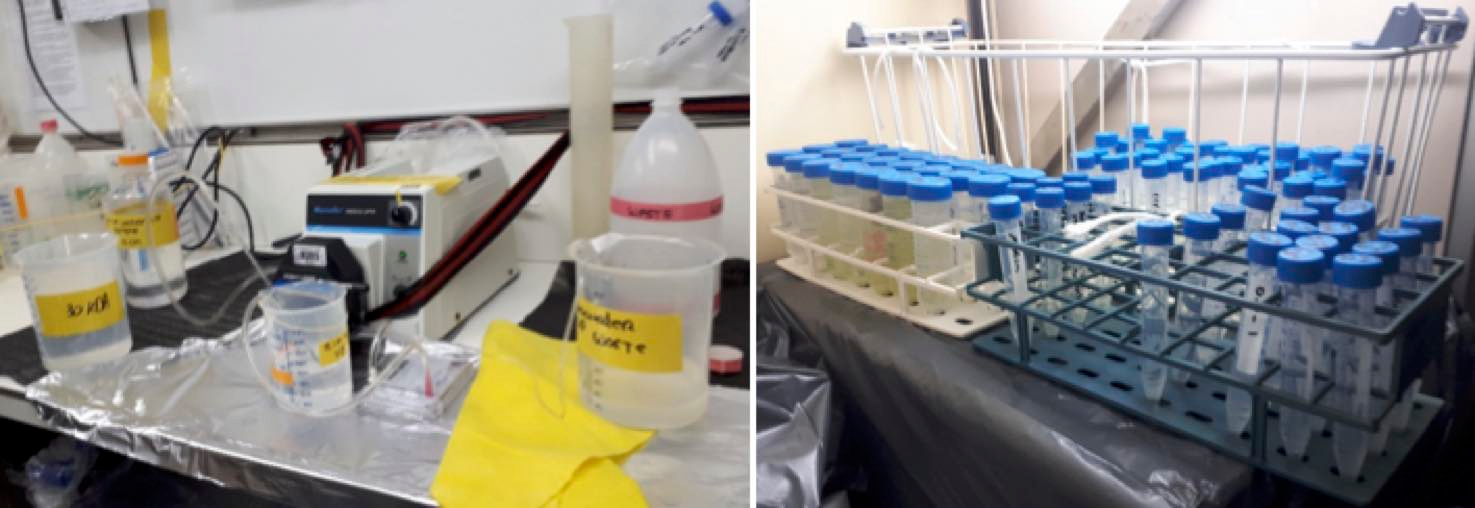
Deutsche: Mein Name ist Claudia Meyer und ich werde im Oktober als Doktorandin am NIOZ und der Universität zu Amsterdam anfangen. Meine Arbeit wird sich mit Viren beschäftigen, die Phytoplankton infizieren. Insbesondere interessiert mich, wie verschiedene Viren, die denselben Wirt haben, koexistieren können und welche ökologischen Konsequenzen diese Koexistenz für den Wirt hat. Als mir meine Betreuerin, Prof. Dr. Corina Brussaard angeboten hat, an dieser Fahrt teilzunehmen und den Ozean zu erforschen, habe ich natürlich sofort die Gelegenheit ergriffen, insbesondere da der Hauptteil meiner Arbeit Labor- bzw. Computerbasiert sein wird.
Hier an Bord verbringe ich einen Großteil meiner Zeit damit, Liter um Liter Meerwasser zu filtrieren, welches wir mithilfe einer CTD und eines Schlauchbootes an Deck holen. Das Ziel dieses Filtrierens ist es, DNA aus Algen, Bakterien und ihren Viren zu sammeln und später, zurück am NIOZ, mit molekularen Methoden zu untersuchen. Dadurch erhoffen wir uns, mehr über die mikrobiellen Lebensgemeinschaften im Meer und ihre Viren zu erfahren. Auf dem Weg von den Azoren nach Süden, bis fast zum Äquator, konnten wir schon ein Nord-Süd Transekt an Wasserproben sammeln. Auf dem Weg in die Karibik wollen wir nun auch noch ein Ost-West Transekt beproben. Dabei beproben wir stets verschiedene Wassertiefen von der Meeresoberfläche bis hinunter zum DCM (deep chlorophyll maximum/tiefes Chlorophyll Maximum). Mit dem Schlauchboot nehmen wir zudem auch Wasserproben direkt unter Sargassum Feldern, ein Unterfangen, das sich als ziemlich herausfordernd herausgestellt hat. Neben wertvollen wissenschaftlichen Proben sorgt diese Art der Probenahme auch für ein gutes Fitness Work-out, da wir die vielen Liter Probewasser zu unserem Containerlabor tragen und viele Behälter, Flaschen und Schläuche nach jeder Probenahme gereinigt werden müssen.
Neben den molekularen Proben liegt der Hauptfokus unserer Arbeit darauf, die Zusammensetzungen und Interaktionen der verschiedenen Gruppen des mikrobiellen Nahrungsnetzes zu untersuchen. Dafür führen wir unter anderem Versuche zu bakterieller Produktion, zu Grazing und zu viral induzierter Mortalität durch. Darüber hinaus haben wir außerdem eine Reihe von Experimenten angesetzt, mit welchen wir neue Algenstämme und neue potenzielle Viren isolieren wollen. Für letzteres haben wir eine Reihe von Algenkulturen aus der Kollektion des NIOZ mitgebracht, welche wir nun mit den gesammelten Wasserproben versetzen. Die Arbeit mit lebenden Organismen (sowohl die Kulturen als auch die Wasserproben welche wir sammeln) ist immer eine Herausforderung, besonders an Bord eines Forschungsschiffes. Bei der Probenahme ist viel Vorsicht geboten, um die Zellen nicht zu beschädigen. Da die Mikroorganismen, welche wir aus unterschiedlichen Wassertiefen sammeln, sehr empfindlich gegenüber Veränderungen in Lichtintensität, Temperatur oder der Wasserzusammensetzung (z.B. Salinität) sind, müssen wir ihren Bedürfnissen so genau wie möglich entsprechen. Für meine Kulturen bedeutet dies, dass, sofern ich es schaffe, sie die Fahrt über am Leben zu halten, diese neuen Algen und Viren als großartige Grundlage für meine Labor Experimente zurück am NIOZ dienen können.
Claudia Meyer
future PhD candidate at NIOZ & University of Amsterdam, supervised by Prof. Corina Brussaard
July 27th | Sargassum stranding simulation
I am a Brazilian PhD student interested in understanding how bacterial communities and Sargassum interact. Although I have always worked with coastal species, I have sailed away into the open ocean to meet the oceanic Sargassum, also known as the golden floating forest. The golden floating forest drifts in the surface layers of the water, and travels long distances in the open sea. However, the Sargassum journey doesn't always end well. Reports of Sargassum strandings have been increasing in the past few years in Mexico, the Caribbean Islands, Brazil and Africa. Stranded Sargassum starts to rot and releases toxic chemicals requiring hard work to clean from beaches. Such stranding also reduces the interest of tourists to go to the beach, but might also increase their curiosity over the new event.
We can search for ways to better use the material washed ashore. To do so, we are simulating a stranding on board aboard the RV Pelagia, investigating the rotting process of different species of Sargassum after exposure to the sun. Samples are periodically taken to do biochemical profiling, as well as the identity of the bacterial community associated with it. By the end of the investigation, we will know the content of lipids, proteins, and carotenoids among other chemical properties that might be of commercial interest. We will also know how the bacterial community changes giving us an idea of the best time to extract byproducts before it is degraded. We have already encountered patches of Sargassum and the experiments are ongoing. I will have a lot of samples to process when I get back to Brazil but also a lot of good information to be generated and shared.
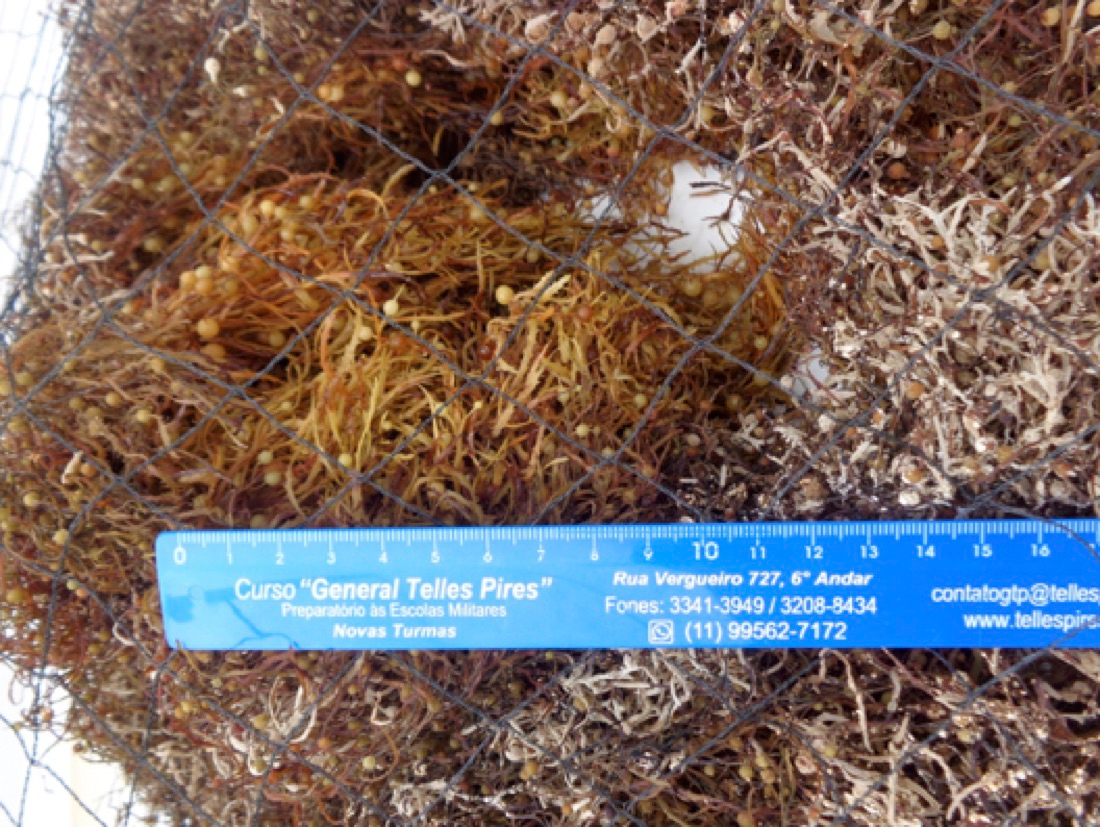
Português - Sou uma aluna de doutorando brasileira interessada em entender como a comunidade bacteriana e o Sargassum interagem. Embora eu sempre tenha trabalhado com espécies costeiras, naveguei pelo mar aberto para conhecer o Sargassum oceânico, também conhecido como a floresta flutuante dourada. A floresta flutuante dourada deriva na camada superficial de água e viaja longas distâncias pelo mar aberto. No entanto, a jornada do Sargassum nem sempre termina bem. Registros de arribada de Sargassum têm aumentado nos últimos anos no México, nas ilhas do Caribe, no Brasil e na África. O Sargassum arribado começa a apodrecer e libera produtos químicos tóxicos exigindo a formação de uma força tarefa para limpar as praias. Tais arribadas também reduzem o interesse dos turistas de ir à praia, assim como também pode aumentar sua curiosidade sobre o novo evento.
Podemos procurar maneiras melhores de utilizar o material arribado. Para isso, estamos simulando uma arribada a bordo do Pelagia para investigar o processo de decomposição de diferentes espécies de Sargassum após a exposição ao sol. Amostras são periodicamente coletadas para fazer o perfil bioquímico do Sargassum, assim como a identificação da comunidade bacteriana associada a ele. Ao termino da pesquisa, saberemos o conteúdo de lipídios, proteínas, carotenóides, entre outras propriedades químicas que podem ser de interesse comercial. Também saberemos como a comunidade bactéria muda de modo a sabermos o momento para extrair subprodutos antes que eles sejam degradados. Nós já encontramos manchas de Sargassum e os experimentos estão em andamento. Eu terei muitas amostras para processar quando voltar ao Brasil, mas também terei muita informação boa para ser gerada e compartilhada.
Inara Regina W. Mendonça
PhD student at University of São Paulo, supervised by Dr. Mariana Cabral de Oliveira
July 23rd | Satellite Oceanography
One of the big questions about the Sargassum washing ashore in the Caribbean, and now South America and Africa is: “Where does it come from”? Initially it was thought to originate in the Sargasso Sea, a large region in the western North Atlantic around Bermuda. However, recent evidence including satellite remote sensing suggests it may in fact originate much farther south and east, in the North Equatorial Recirculation Region, or NERR, between Africa and South America, a prediction proposed by our collaborator Don Johnson of U, Southern Mississippi, USA. One of the major purposes of our research cruise is to investigate this hypothesis, and we are taking advantage of satellites to both receive and send data to help answer this question. Collaborators Chuanmin Hu and Mengqiu Wang at the Univ. of S. Florida, USA, are providing updates of where they detect Sargassum using satellite data, directing our cruise track and sampling locations in the “Sargassum belt” centered around 7° N latitude. While we are in this belt, we are periodically launching drifters that float at the surface of the ocean and move with the water and the Sargassum. These drifters have GPS transmitters that can be detected by satellites, so we know the location of each drifter as it moves over time. We are using two types of drifters:
- SVP (Surface Velocity Program) drifters have a large round float attached to a drogue or “sea anchor” hanging down 5 m or more into the water. These were provided by Shaun Dolk at NOAA/AOML/PhOD, Miami, FL, USA, and are designed to move with the upper mixed layer of seawater.
- Stokes style drifters are very small units only 10-cm tall that float right at the surface with only 1 cm sticking up above the surface. They are designed to move with the very surface layer of water, in our case hopefully mimicking the way Sargassum drifts, because it also extends about 10 cm below the surface. These were designed and built at NIOZ in collaboration with Erik van Sebille at Utrecht Univ., Netherlands, and based on a design by collaborator Nicolas Wienders at Florida State University, Tallahassee, FL, USA.
We launch both types of drifters together so that we can determine how Sargassum (and anything else in the surface layer such as floating plastic) moves in the ocean. As you can see from the list of collaborators above, figuring out where, why, and how Sargassum is building up and drifting ashore requires a large group of collaborators with different areas of expertise.
Erik Zettler
Guest-researcher in Amaral-Zettler research group, NIOZ Royal Netherlands Institute for Sea Research
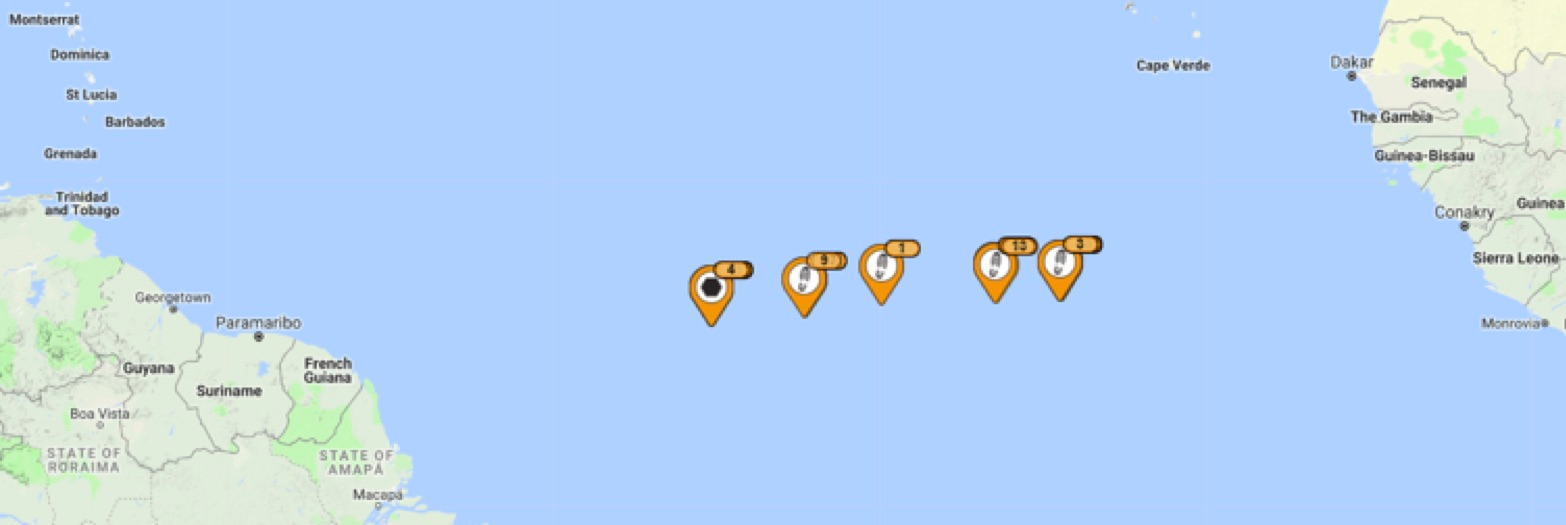
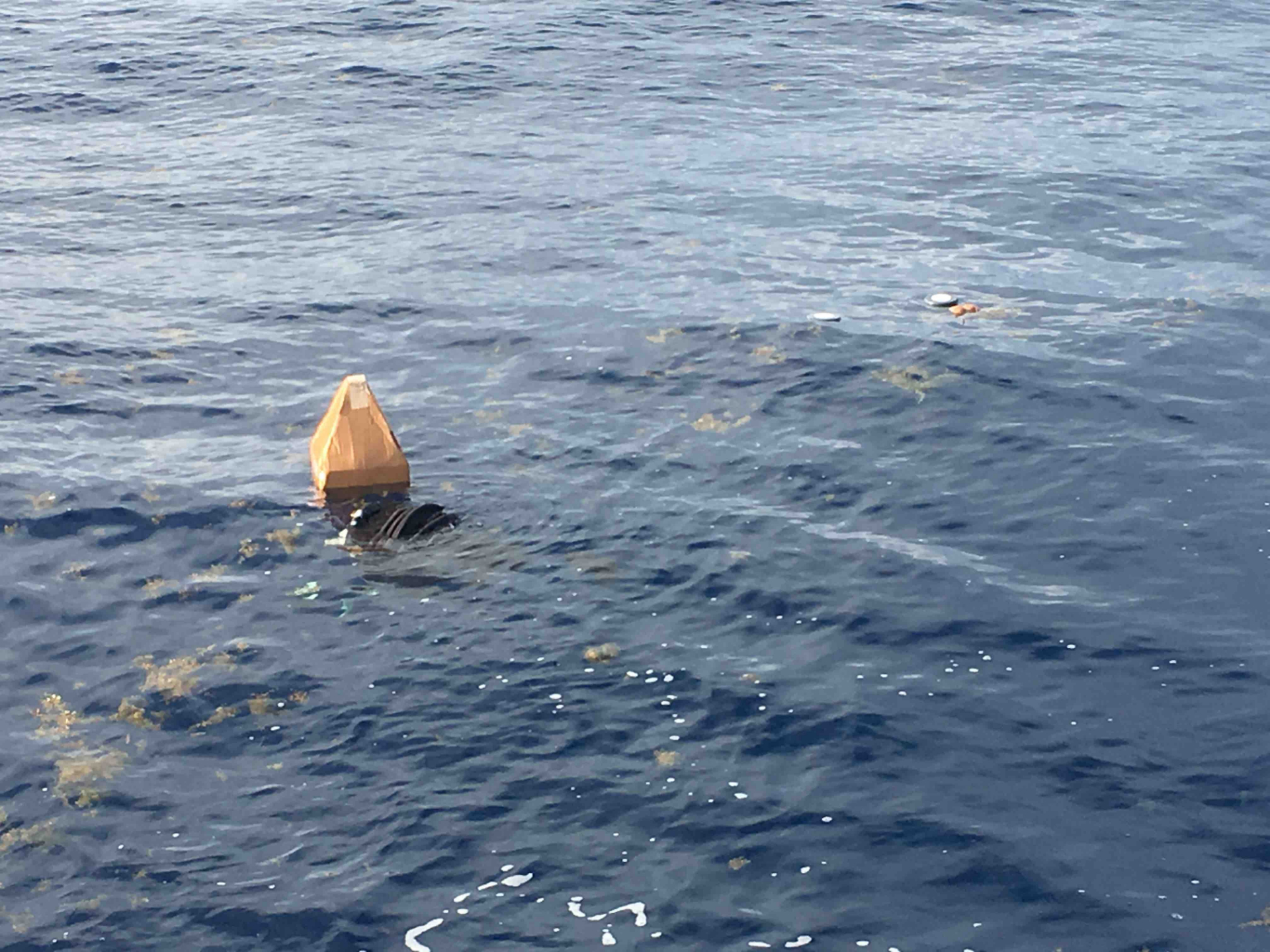
July 22nd | Molecular Ecology on the High Seas
My name is Tom Theirlynck and two months ago I started as a PhD candidate at the University of Amsterdam and NIOZ Royal Netherlands Institute for Sea Research. Aiming to train me as a proper marine biologist, my supervisor Prof dr Linda Amaral-Zettler immediately sent me on a research cruise at sea: a quest for the floating brown alga Sargassum.
Looking at the patches of Sargassum in the water, overflowing with aquatic life ranging from small shrimps to large fish, it is hard to imagine that this brown alga can be responsible for one of the main tropical coastal environmental issues. However, over recent years floating Sargassum has started forming unprecedented accumulations on the coasts of the Caribbean that threatens biodiversity and highly impacts tourism. Even though recent evidence suggests that these Sargassum accumulations are here to stay, there are a lot of basic questions that we still need answers. What makes this particular alga grow in such enormous amounts and what Sargassum species are responsible for these accumulations? These questions in particular have a fundamental molecular basis that I will focus on during my PhD research.
A molecular approach comes in handy when researching what Sargassum species we see in the waters along our cruise track. In our research group, we have developed a method to isolate the Sargassum DNA and with help of high-end molecular equipment, carefully tied down to accompany the movement of the Atlantic Ocean, we can identify the species on shipboard of the research vessel as we do in our lab on land. This molecular procedure is quite an important feature because the three species of Sargassum are often challenging to identify on basis of their looks alone. Interestingly with help of these molecular tools, we are already seeing a large variety in the dominating Sargassum species per geographic area. The dominant species that we encountered at the start of the expedition near the Azores is not the same dominant species we found in the nets on our current location just above the Equator. As we continue on our way, the Sargassum species' distributions seem to be rapidly ever changing. Back at NIOZ we will further characterize our Sargassum samples through DNA sequencing. By studying the small molecules like DNA, we hope to gain insight in the large environmental issues that Sargassum encompasses.

Nederlandse versie: Mijn naam is Tom Theirlynck en ik ben sinds twee maanden begonnen als PhD kandidaat aan de Universiteit van Amsterdam en het NIOZ Koninklijk Nederlands Instituut voor Onderzoek der Zee. Om mij optimaal in te leiden als mariene bioloog, stuurde mijn begeleider Prof. Linda Amaral-Zettler mij meteen op onderzoekscruise op zee: een zoektocht naar het bruinwier Sargassum.
Kijkend naar de matten van Sargassum in het water, van top tot teen gevuld met aquatisch leven als kleine garnalen en grote vissen, is het moeilijk voor te stellen dat dit bruinwier verantwoordelijk is voor één van de belangrijkste milieuproblemen in de tropische kusten. Sargassum vertoont de laatste jaren echter een ongeremde groei bij de kusten van de Cariben waarmee het de biodiversiteit ernstig bedreigt en het toerisme schaadt. Recentelijk onderzoek wijst uit dat dit een verandering is in het ecosysteem die wel eens blijvend zou kunnen zijn, maar toch zijn er veel vragen onbeantwoord. Wat maakt dat juist dit wier zo enorm groeit en welke soort ondergaat deze onverstoorbare groei? Dit zijn precies vragen met een fundamentele moleculaire basis waar ik mij op toeleg in mijn promotie onderzoek.
Deze moleculaire aanpak is met name nuttig wanneer wij onderzoeken welke Sargassum soort het meest voorkomt in de wateren op de route van onze cruise. In onze onderzoeksgroep hebben wij een methode ontwikkelt om het Sargassum DNA te isoleren met behulp van hoogstaande moleculare machines, die nauwkeurig zijn vastgebonden tegen de golven van de Atlantische Oceaan, zodat wij de soort kunnen identificeren aan boord van het onderzoeksschip, zoals wij dat normaal in het lab op het land zouden doen. Deze moleculaire procedure is zeer belangrijk, omdat de drie soorten van Sargassum op basis van hun verschijning alleen bijna niet uit elkaar te houden zijn. Interessant genoeg zien wij met behulp van deze moleculaire methode al een grote variatie in de verspreiding van de drie Sargassum soorten. De veelvoorkomende Sargassum soort die wij zagen in de wateren rond de Azoren, blijkt niet dominante soort in onze huidige locatie iets boven de evenaar. Terwijl wij onze onderzoekscruise voortzetten zien wij de soorten distributie eigenlijk continu veranderen. Terug op het NIOZ zullen wij de genomen Sargassum monsters verder analyseren door DNA sequencing. Door het bestuderen van de kleinste moleculen zoals DNA, hopen wij inzicht te krijgen in de grote milieuproblemen die Sargassum met zich meebrengt.
Tom Theirlynck
PhD candidate at NIOZ & University of Amsterdam, supervised by Prof dr Linda Amaral-Zettler and Prof dr Gerard Muyzer
July 19th | The influence of Sargassum on open-ocean microbial communities
For those who know my research it might be a bit strange to hear I am joining a Sargassum-focused cruise. I am a microbial oceanographer that usually studies small organisms in the seas and ocean undetectable to the human eye. These unicellular microorganisms make up most of the living biomass in the ocean and form the base of most marine food webs. The heterotrophic bacteria are important agents of recycling (element fluxes) and the unicellular algae (phytoplankton) are globally responsible for taking up large quantities of carbon dioxide while producing the oxygen we live on.
Most of the time I study these microbial interactions and the loss of microbes due to viral infection (in comparison to the traditionally dominant grazing loss factor) in the open North Atlantic Ocean, North Sea and polar waters. This time my research will focus on what happens with these microbes under the Sargassum patches/fields. The floating Sargassum forms a unique ecosystem, with many different animals attached to or being shielding by and under the Sargassum. Some animals are so well adapted to this life style, you may miss them easily when pulling up a piece of Sargassum: many have a camouflaged appearance and body color! (e.g. see the Sargassum sea slug photo). Small fish hide from predators under the Sargassum and all in all, the resulting ecosystem holds an ecologically important function. I would now like to know what the consequences are for the phytoplankton and bacteria living in these waters under the Sargassum. In a time where large quantities of Sargassum are formed and finally strand on the shores more and more, it is warranted to study not only where and why there is much more Sargassum formed and what larger organisms make use of these Sargassum fields, but also what it means for the functioning of the upper ocean water column, hence my interest in Sargassum.
I am lucky to be able to do this research with the help of a good team, i.e. the experienced lab-technicians Anna Noordeloos and Santiago Gonzalez from NIOZ, and Claudia Meyer who will be a new PhD student in my lab studying the ecological effects of coexistence of different marine viruses infecting the same phytoplankton host. We are already collecting water samples on our way south to the Sargassum belt. Within 2 days we expect to be super busy with the sampling in and out of Sargassum patches (by rubber boat – more on that in a later blog), and the subsequent processing of these samples when back onboard RV Pelagia.
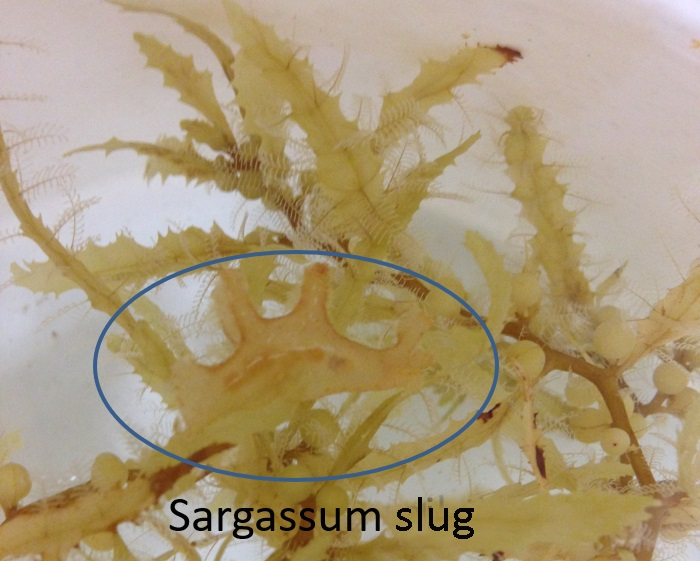
Nederlandse versie: Voor degene die mijn onderzoek kennen lijkt het misschien een beetje vreemd dat ik een met een cruise mee ben die onderzoek doet aan Sargassum. Als een mariene microbioloog bestudeer ik de voor het menselijk oog niet waarneembare kleine organismen in de oceanen. Deze eencellige microorganismen vormen het grootste deel van de levende biomassa in zee en vormen ook de basis van de meeste voedselketens. De bacteriën zijn belangrijk in de recycling (element fluxen) en de eencellige algen (fytoplankton) zijn in totaal verantwoordelijk voor de opname van grote hoeveelheden koolstofdioxide en de productie van zuurstof, waar wij weer van leven.
Tijdens mijn werk besteed ik de meeste tijd aan het bestuderen van microbiële interacties en de sterfte van microorganismen door virale infectie (in vergelijking met de traditioneel belangrijke verliesfactor begrazing) in de open Noord Atlantische Oceaan, Noordzee en de poolzeeën. Deze keer focus ik het onderzoek op wat er gebeurt onder de Sargassum velden. De drijvende Sargassum vormt een uniek ecosystem, met vele verschillende dieren die op en tussen de Sargassum leven. Sommige dieren zijn zo goed aangepast aan de Sargassum dat je ze niet zomaar ziet als je een stuk Sargassum oppakt (zie bijvoorbeeld de Sargassum slak op de foto). Kleine vissen schuilen onder de Sargassum voor predatoren en alles bij elkaar vervullen deze Sargassum velden een belangrijke ecologische functie. Ik wil nu graag weten wat de gevolgen zijn voor de fytoplankton en bacteriën die in deze wateren onder de Sargassum leven. In een tijd waar meer en meer grote hoeveelheden Sargassum worden gevormd en uiteindelijk op de stranden aanspoelen, is het belangrijk om niet alleen te onderzoeken waardoor en waarom dit gebeurt en welke grotere organismen hier gebruik van kunnen maken, maar juist ook wat het betekent voor het functioneren van het microbiële leven in de bovenste waterkolom. Vandaar mijn interesse in Sargassum.
Ik heb het geluk dit onderzoek te doen met de hulp van een goed team: de ervaren lab-assistenten Anna Noordeloos en Santiago Gonzalez, en Claudia Meyer, een nieuwe promotiestudent in mijn lab die zal onderzoeken wat de ecologische gevolgen zijn van coexistentie van verschillende virussen die dezelfde mariene fytoplankton gastheer infecteren. We zijn nu, op weg naar het zuiden (Sargassum velden), ook al watermonsters aan het nemen, maar binnen 2 dagen verwachten we dat we echt super-bezig zullen zijn met het verzamelen van watermonsters onder en buiten een Sargassum veld (met een rubberboot – hierover mee in een latere blog) en de verwerking van deze monsters zodra we weer aan boord zijn van de Pelagia.
Corina Brussaard
NIOZ 64PE455 Principal Investigator
July 16th | Meiofauna in the Golden Floating Rainforest
A great adventure has begun under Neptune’s eyes in search of the Golden Floating Rainforest. On board technicians, sailors, and scientists are exchanging ideas, forging new collaborations, meeting and enjoying the scientifically stimulating environment. For the moment, little Sargassum is in sight, but we are heading towards the NERR with anticipation. My own project focuses on meiofauna in Sargassum. What is meiofauna? Why do I study meiofauna? The meiofauna are small organisms, larger than microfauna and smaller than macrofauna that are retained on a 63  m mesh sieve. Their small size allows easy lab manipulation. It is among meiofauna that we seek to evaluate heavy metal contamination and plastic ingestion, in particular nanoplastics, resulting from the degradation of macroplastics and microplastics within Sargassum. For the moment the meiofauna identified is different than the meiofauna found in mangroves of Guadeloupe (French West Indies). This promises to be a fun, intriguing, and exciting cruise onboard the RV Pelagia.
m mesh sieve. Their small size allows easy lab manipulation. It is among meiofauna that we seek to evaluate heavy metal contamination and plastic ingestion, in particular nanoplastics, resulting from the degradation of macroplastics and microplastics within Sargassum. For the moment the meiofauna identified is different than the meiofauna found in mangroves of Guadeloupe (French West Indies). This promises to be a fun, intriguing, and exciting cruise onboard the RV Pelagia.
French version: Une grande aventure à commencé sous les yeux Neptune, à la recherche de la forêt flottante dorée. A bord du navire il y a des techniciens, des marins, des scientifiques qui échangent, mais aussi de belles rencontres, découvertes, dans un esprit scientifique. Pour le moment, toujours pas de Sargasse en vue mais nous nous dirigeons avec impatience vers NEER. Aujourd’hui je vais juste vous parler de mon travail et de mes recherches: la méiofaune. Qu’est que la méiofaune? et pourquoi j’etudie la méiofauna? La méiofaune comprend des organismes de petite taille, plus grand que la microfaune mais plus petit que la macrofaune, leur taille correspond à tous les organismes retenus dans un tamis dont la maille est de 63  m. Leur petite taille leur confere une facilité de manipulation en laboratoire. C’est parmi la meiofaune que l’on va essayer d’évaluer une contamination par les métaux et les nanoplastiques (issus de la degradation des macroplastiques et des microplastiques), au sein de Sargassum. Pour l'instant, la méiofaune rencontrée est differente de celle presente dans les mangrove de Guadeloupe. Voilà un voyage qui promet d’être intrigant amusant excitant et tout cela à bord du RV Pelagia.
m. Leur petite taille leur confere une facilité de manipulation en laboratoire. C’est parmi la meiofaune que l’on va essayer d’évaluer une contamination par les métaux et les nanoplastiques (issus de la degradation des macroplastiques et des microplastiques), au sein de Sargassum. Pour l'instant, la méiofaune rencontrée est differente de celle presente dans les mangrove de Guadeloupe. Voilà un voyage qui promet d’être intrigant amusant excitant et tout cela à bord du RV Pelagia.
Oceanne-Amaya Cipolloni
PhD candidate at the University of Antilles (French West Indies) with Dr. Pierre-Yves Pascal.
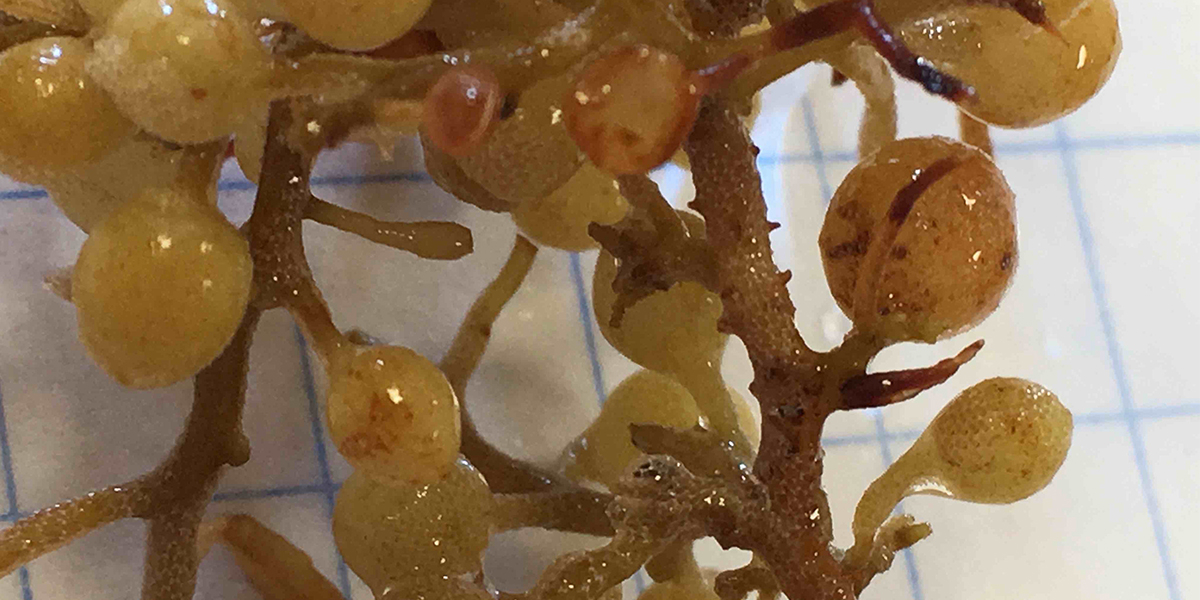
July 12th | In Search of ... Sargassum
Our journey aboard the R/V Pelagia began on the 11th of July with a smooth departure from the Azorean port of Ponta Delgada, São Miguel (Portugal). The unifying theme of our cruise is Sargassum - the open-ocean brown macroalga sometimes referred to as the "Golden Floating Rainforest" (see photo), since it often forms floating carpets on the sea surface that house at least 10 known endemic species, and serves as a nursery and home to many others. A major objective of our cruise is to study the genetic diversity of this ecosytem - giving the cruise its nickname "SarGO" for Sargassum Genomic Observatory, but as you'll see in a series of blogs our scientists will prepare over the course of the next five weeks, we have a very varied and interdisciplinary scientific program planned. Our unexpected encounter with Sargassum mats while exiting the Azorean EEZ left us wondering what other surprises lay in store for us. While Sargassum is not typically found in abundance so far east in the North Atlantic, the Sargasso Sea's eastern most extent stretches to the Azores Islands, and thus perhaps it is not so surprising to find sargaço (the Portuguese name for the golden seaweed and the Sargasso Sea's namesake) just south of these mid-Atlantic islands. In addition to collecting important information about the expanding geographic range of this macroalga - we are also taking advantage of colleagues ashore to help guide us in our search for Sargassum.
Linda Amaral-Zettler
NIOZ Chief Scientist, 64PE455
